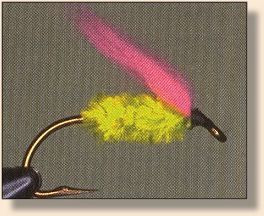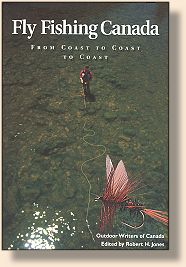Tempting Tackle-Busting Chums
By Dr. Martin Lamont
From Fly Fishing Canada, Published by Johnson Borman Publishers
Of the Pacific salmon, Chums (Oncorhynchus keta) were of
little interest to saltwater anglers until the 1990s. With El Nino - related distuptions
in coho and chinook stocks during that period, more attention was directed at these
late-running salmon and a popular fishery - mostly involving trolling with lures or
mooching with cut plug herring - began to evolve. Those anglers quickly learned
what fly fishers in rivers have known all along: chums are strong, brutal brawlers.
In fact, many anglers feel that pound-for-pound they are the strongest of all Pacific
salmon.
Large numbers of chums enter the rivers when low-pressure weather systems of late
fall sweep in from the ocean, drenching the West Coast with heavy rains. Chums
seldom migrate far upstream, especially in short rivers like those found on Vancouver
Island, and are often found in lower reaches close to the estuary. A good starting
point is from the first tidal pool to 1 miles (1.6 km) upstream. For this reason it
pays to check local tide tables for the flood tide, which usually brings fresh, new
fish into the lower reaches. [Also check the local regulations, some rivers may not
be open to any fishing above the tidal high water mark at the mouth of the estuary.]
By the time chums enter a river, their ocean mantle of bright silver is taking on a
distinctive pattern of mottled red-purple and green-olive hues. The males, their
hooked kypes armed with fierce-looking teeth, are aggressive and spoiling to
fight with each other over the redds. It is this attack mode a fly fisher stimulates
by presenting a fly, which is basically an attractor pattern.

Some basic patterns are simple yarn flies in fluorescent green or red. In the
often muddied spate waters of fall, green offers greater visibility to the fish.
However, there is no exact formula for chums, so experient occasionally with
blue or yellow-orange yarn. My favorite pattern is the Green and Pink Frammus
originated by Vic Stevens of Courtenay, British Columbia. Although intended
for winter steelhead, it works well for chums. It is simply a body of green
chenille and a wing of pink acrylic yarn, or reversed with a pink body and green
wing. I use No. 6 - 2 hooks, with the larger size for colored water.
Those new to chum fishing often underestimate these heavyweights and use tackle that is too
light for the task. While the average weight of male chums is about 10 lb (4.5 kg), they
have been recorded at well over three times this size. Even 10-lb chums can be
unbelievably strong tackle-busters, so a 9-10-weight outfit is suggested. My favorite
is a 12', 10-weight fiberglass rod, treasured for its ability to take the pounding and
abuse of chum fishing.
A sink-tip line with a shortened head is useful for mending a dead-drift through
pods of schooling chum. Alternatively, try a floating line in shallower flows.
Tippets should be heavy - nothing less than 10-lb test - 4' (1.25 m) long for
colored water, 9' (2.75 m) in clear conditions. Flies can also be presented with
a classic down-and-across swing. At the end of each drift, let your fly hang
downstream in the current for a short while, then retrieve upstream with steady,
slow-to-medium pulls of 2' (60 cm) or so (reel to knee), and be prepared for an
often subtle take.
 Take care when approaching chums holding in thin water as they spook easily.
In colored water they prefer slower flows close to the bank or in back eddies,
and they often hold right at an angler's feet. If you can see fish but they
refuse to bite, remember that they are not feeding - you must trigger that attack
mode. Present your fly repeatedly over the same area and at the same depth
before covering new water. Fish fresh from the ocean are ready takers, but
shortly after settling over the redds, they lose interest in biting flies.
Take care when approaching chums holding in thin water as they spook easily.
In colored water they prefer slower flows close to the bank or in back eddies,
and they often hold right at an angler's feet. If you can see fish but they
refuse to bite, remember that they are not feeding - you must trigger that attack
mode. Present your fly repeatedly over the same area and at the same depth
before covering new water. Fish fresh from the ocean are ready takers, but
shortly after settling over the redds, they lose interest in biting flies.
The window of opportunity to tangle with these esceptionally strong, challenging
opponets is admitttedly short, but we who are addicted to chum salmon feel they
are well worth the effort.
~ Dr. Martin Lamont
Credits: From Fly Fishing Canada, From Coast to Coast to Coast
By Outdoor Writers of Canada, Published by Johnson Gorman Publishers.
We appreciate use permission!
Our Man In Canada Archives
|


 Take care when approaching chums holding in thin water as they spook easily.
In colored water they prefer slower flows close to the bank or in back eddies,
and they often hold right at an angler's feet. If you can see fish but they
refuse to bite, remember that they are not feeding - you must trigger that attack
mode. Present your fly repeatedly over the same area and at the same depth
before covering new water. Fish fresh from the ocean are ready takers, but
shortly after settling over the redds, they lose interest in biting flies.
Take care when approaching chums holding in thin water as they spook easily.
In colored water they prefer slower flows close to the bank or in back eddies,
and they often hold right at an angler's feet. If you can see fish but they
refuse to bite, remember that they are not feeding - you must trigger that attack
mode. Present your fly repeatedly over the same area and at the same depth
before covering new water. Fish fresh from the ocean are ready takers, but
shortly after settling over the redds, they lose interest in biting flies.